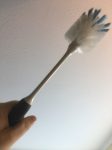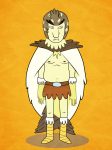Besides washing glassware, I took a little time to experiment with video microscopy today. I didn’t get great results, but I’ll keep working on it.
Besides washing glassware, I took a little time to experiment with video microscopy today. I didn’t get great results, but I’ll keep working on it.

The water in the science building was restored the other day, but yesterday when I used the faucet nothing but rusty brown horrible water was coming out of it. I’m going in today and will flush the pipes in my lab for a while, and then, at last, I will get to use my glorious new bottle brush to wash all the glassware. I am so excited! Wouldn’t you be? Doing the dishes, making everything all shiny, getting all the clutter put away…this is exactly why I got a Ph.D.
I’ll also be able to indulge in some spider therapy. You people don’t know what you’re missing by not spending time with a whole lot of eyes and twitching legs and fanged bodies walking the tightrope of an intricate web. You’re all invited to come on over (as long as you’re masked and vaccinated) and take in the restful spectacle. Maybe you can wash a bottle or two while you’re here?
I was meditating in the lab today. Very restful.
If you have no idea what Silkhenge is, here’s a video:
It’s a curious ring of spider silk, with silk fenceposts, and then in the center, an egg sac with a silk spike coming off the top. It’s just weird, especially since it’s such an elaborate structure to house only a handful of spider eggs. It’s a lot of effort for a small reward. All we know is what the babies look like, no adults, and no observations of how it is constructed. Clearly, More Research is Needed.
The same people went back a few years later and found more examples, still no adults.
They’ve also been seen in Peru.
Do I need an excuse to visit Ecuador again? Will this do? (All exotic travel is pending the resolution of the pandemic, of course.)

That is my sad face. I went into the lab yesterday to get a bunch of things done, when I learned that the water to the whole building was shut off. Our science building is only about 20 years, but every year we have a battery of problems that shake out — rooms are too hot or too cold, the roof leaks, and come the winter, we often get pipes freezing and all the problems that causes. So no water for three days while the maintenance crew fixes everything.
This would have been catastrophic when I was working with fish, and it’s still awkward when working with spiders. On my list was the need to set up more flies so they’d have food in two weeks, washing spider poop out of their containers, and most tragic of all, I had set hundreds of vials soaking in soapy water the day before, and I was going to scrub ’em up and rinse them out and dry them yesterday.
Look! I even got a brand new bottle brush! I was so excited to be doing dishes, and then…crashing disappointment. I’ll have to wait until Thursday.

I was inspired by this essay by Amal El-Mohtar, who is building a tradition of finding A New Year’s Bird. I like it, it seems like a lovely way to start the year, but I’m not much of a bird person — that’s my wife’s thing. By the way, Mary is right next to me, staring out the window at the visitors to our bird feeders as part of her participation in FeederWatch. But you know me, I’m more of a spider person. Sorry. Not sorry.
It was clear, though, that I need a New Year’s Spider. I began my quest.
One easy possibility was that, this morning, as I showered and reached into the soap dish, I startled a small cellar spider, which scurried frantically away. I girded myself with my camera and walked the few feet to our bathroom to search for the little fellow.
I failed. It was not there any longer. That was OK, though, because that is how all quests must begin, with failure and frustration, and we then find redemption through struggle. I will find the beast.
The bathroom had to be explored. The lights above the bathtub are separated by a grid, a hot spot for spider webs, and there was plenty of spoor. The space was dusty and full of cobwebs, and I searched everywhere, finding diaphanous fluff everywhere, but not a hint of the spider. They are cunning and cautious, and are good at finding small cracks in the walls and hiding in the space between the drywall and siding, inaccessible to giants like me.
Where must I go? There’s no doubt. At some point in a quest, we must descend into the underworld. Our basement, that is — a dark, cold place, neglected and unfrequented by people, where we never dust or clean, where spider-kind can flourish. But again, this is mid-winter, and even spiders struggle when the cold obliterates their prey, and survival is a matter of patience and stillness and long waiting. I lit a torch, opened the creaking, little-used door, and descended the narrow stairs into the cavern.
The space is mostly empty, containing a few dusty relics from a time when it was inhabited by boisterous teenagers, but now barren of anything that might attract a human visitation, except, in my case, billowing cobwebs. Those cobwebs were all empty of life, unfortunately. Not even spiders find this basement an oasis in the depths of winter — too cool, too empty of food, too gloomy. I searched the main room and found a few traces of previous occupation, mainly molted skeletons lying about like the carcasses of facehuggers. Where are they now, I wondered? What victims were drained of blood after they shed their cuticle?
Further. I went deeper, and found the basement ogre: a large sheet web, a meter across, with scraps of cuticle scattered about, and imbedded in the area the skeletons of large prey, houseflies and bumblebees, that had stumbled into this cursed place and found their doom. There was movement on the sheet! I briefly glimpsed a large funnel weaver, horrified by the bright light I’d brought into their domain. It immediately scuttled back into it’s lair, refusing to face me. I could not count this as my New Year’s Spider. I needed a bold creature that would face me, stare into my eyes, and not retreat like a coward. There was no honor in this spider.
Deeper still, I went into the small twisty rooms in the back, where the furnace burned. What I immediately found was…death. The spiders had retreated into the faint warmth as cold seeped into the underworld, finding final refuge where the hot heart of the house dwelt, and many had died in the process. So many spider corpses! So many large carcasses dead in their webs, on the wall, on the ceiling.
I knew I was close. How else would a quest go? First the barren land, then the monster in the dark, then death, then finally, the grail and revelation. There she was, queen of the dark world, my New Year’s Spider, resting on the underside of a shelf, gazing unafraid and unmoving at me.
Returning to the land of light, I can now rest with a sense of accomplishment, perhaps ready for a new year. As one who has returned, I can now give you a quest, to find your own New Year’s Spider.
Or bird, I guess, if you prefer.
(I know way too many people here are Bird Persons who don’t much care for spiders, so I only posted the text here, with none of the photos of horrifying spider webs, dead spiders, and the Queen of Darkness. You could see all the grisly photos if you’re subscribed to my Patreon, or you can see the spider queen on Instagram.)
I had to look at what they were saying about these beautiful animals, and <shock, horror> they are lying about their evolution. Oh well, it gave me a chance to compare ID creationists to YE creationists. There is a little difference there.
Script below the fold for all of you who hate watching videos.
What a nicely decorated Christmas tree!

As a final touch, it really needs a dessicated corpse dressed in a red suit somewhere beneath the tree.
I’m pretty sure I know where I fit in the scale of spider people, where are you?

The health minister in Queensland, Australia was interrupted when a huntsman was found crawling on her.
Wait, wait, she’s talking about the impact of COVID-19 on her community — the spider is cute and adorable (although we don’t even get a photo of it), but isn’t that a relatively unimportant part of the event to be making the news? If I were there, I’d volunteer to cuddle the spider so she can get on with the important message.
